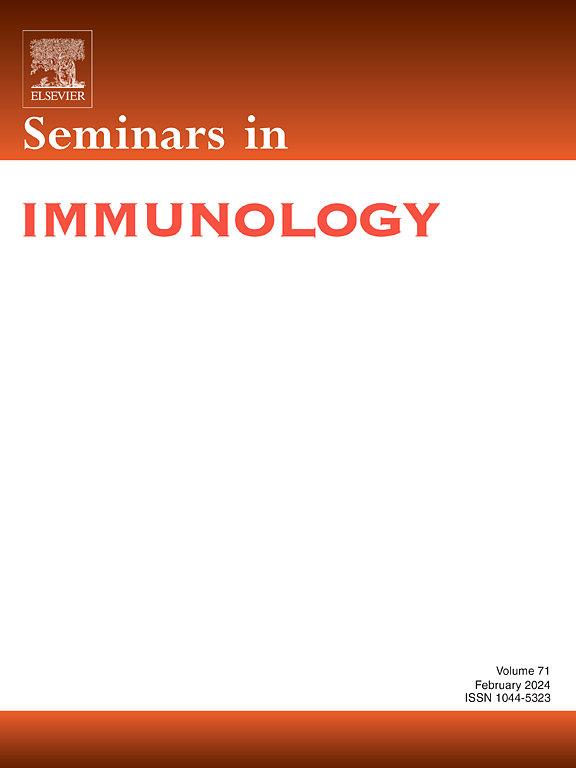Unraveling the pathophysiology of narcolepsy type 1 through hypothesis-driven and hypothesis-generating approaches
IF 7.4
2区 医学
Q1 IMMUNOLOGY
引用次数: 0
Abstract
Narcolepsy type 1 (NT1) is a chronic orphan neurological sleep disorder characterized by the loss of hypocretin-producing neurons in the lateral hypothalamus, which play a crucial role in wakefulness. Given the genetic association with the HLA-DQB1 * 06:02 allele and environmental links with the 2009 influenza pandemic, many lines of evidence point towards an immune mechanism, notably autoimmunity, underlying the disease pathophysiology. Autoreactive T cells are found in the blood of NT1 patients, and mouse models demonstrate their migratory capacity and contribution in the selective destruction of hypocretin-producing neurons. However, direct evidence for their role in human NT1 pathophysiology remains elusive. In complementing these findings, hypothesis-generating approaches—including multiparametric immune profiling, transcriptomic sequencing and large-scale proteomic of blood and cerebrospinal fluid—have uncovered promising new avenues into the immune system’s involvement in NT1. In this review, we explore the mechanisms driving NT1 pathogenesis, emphasizing both hypothesis-driven and hypothesis-generating approaches, and discuss potential future directions that could pave the way for targeted immunotherapies.
通过假设驱动和假设生成方法揭示1型发作性睡病的病理生理学
1型发作性睡病(NT1)是一种慢性孤儿神经性睡眠障碍,其特征是下丘脑外侧分泌下丘脑激素的神经元的缺失,而下丘脑外侧分泌下丘脑激素的神经元在清醒中起着至关重要的作用。鉴于与HLA-DQB1 * 06:02等位基因的遗传关联以及与2009年流感大流行的环境联系,许多证据都指向一种免疫机制,特别是自身免疫,是疾病病理生理学的基础。在NT1患者的血液中发现了自身反应性T细胞,小鼠模型证明了它们的迁移能力和选择性破坏下丘脑分泌素神经元的作用。然而,它们在人类NT1病理生理中的作用的直接证据仍然难以捉摸。为了补充这些发现,假设生成方法-包括多参数免疫谱,转录组测序和血液和脑脊液的大规模蛋白质组学-为免疫系统参与NT1发现了有希望的新途径。在这篇综述中,我们探讨了驱动NT1发病机制的机制,强调了假设驱动和假设产生的方法,并讨论了可能为靶向免疫治疗铺平道路的潜在未来方向。
本文章由计算机程序翻译,如有差异,请以英文原文为准。
求助全文
约1分钟内获得全文
求助全文
来源期刊

Seminars in Immunology
医学-免疫学
CiteScore
11.40
自引率
1.30%
发文量
50
审稿时长
89 days
期刊介绍:
Seminars in Immunology is a specialized review journal that serves as a valuable resource for scientists in the field of immunology. The journal's approach is thematic, with each issue dedicated to a specific topic of significant interest to immunologists. It covers a wide range of research areas, from the molecular and cellular foundations of the immune response to the potential for its manipulation, highlighting recent advancements in these areas.
Each thematic issue is curated by a guest editor, who is recognized as an expert in the field internationally. The content of each issue typically includes six to eight authoritative invited reviews, which delve into various aspects of the chosen topic. The goal of these reviews is to provide a comprehensive, coherent, and engaging overview of the subject matter, ensuring that the information is presented in a timely manner to maintain its relevance.
The journal's commitment to quality and timeliness is further supported by its inclusion in the Scopus database, which is a leading abstract and citation database of peer-reviewed literature. Being indexed in Scopus helps to ensure that the journal's content is accessible to a broad audience of researchers and professionals in immunology and related fields.
 求助内容:
求助内容: 应助结果提醒方式:
应助结果提醒方式:


